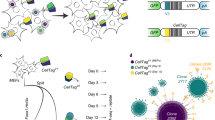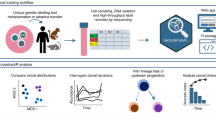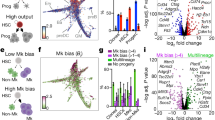Abstract
The number of stem cells contributing to hematopoiesis has been a matter of debate. Many studies use retroviral tagging of stem cells to measure clonal contribution. Here we argue that methodological factors can impact such clonal analyses. Whereas early studies had low resolution, leading to underestimation, recent methods may result in an overestimation of stem-cell counts. We discuss how restriction enzyme choice, PCR bias, high-throughput sequencing depth and tagging method could affect the conclusions of clonal studies.
This is a preview of subscription content, access via your institution
Access options
Subscribe to this journal
Receive 12 print issues and online access
$259.00 per year
only $21.58 per issue
Buy this article
- Purchase on Springer Link
- Instant access to full article PDF
Prices may be subject to local taxes which are calculated during checkout







Similar content being viewed by others
References
Anderson, K. et al. Genetic variegation of clonal architecture and propagating cells in leukaemia. Nature 469, 356–361 (2011).
Notta, F. et al. Evolution of human BCR-ABL1 lymphoblastic leukaemia-initiating cells. Nature 469, 362–367 (2011).
Lemischka, I.R., Raulet, D.H. & Mulligan, R.C. Developmental potential and dynamic behavior of hematopoietic stem cells. Cell 45, 917–927 (1986).
Snodgrass, R. & Keller, G. Clonal fluctuation within the haematopoietic system of mice reconstituted with retrovirus-infected stem cells. EMBO J. 6, 3955–3960 (1987).
Capel, B., Hawley, R., Covarrubias, L., Hawley, T. & Mintz, B. Clonal contributions of small numbers of retrovirally marked hematopoietic stem cells engrafted in unirradiated neonatal W/Wv mice. Proc. Natl. Acad. Sci. USA 86, 4564–4568 (1989).
Abkowitz, J.L. et al. Evidence for the maintenance of hematopoiesis in a large animal by the sequential activation of stem-cell clones. Proc. Natl. Acad. Sci. USA 87, 9062–9066 (1990).
Harrison, D.E., Astle, C.M. & Lerner, C. Number and continuous proliferative pattern of transplanted primitive immunohematopoietic stem cells. Proc. Natl. Acad. Sci. USA 85, 822–826 (1988).
Harrison, D.E., Astle, C.M. & Stone, M. Numbers and functions of transplantable primitive immunohematopoietic stem cells. Effects of age. J. Immunol. 142, 3833–3840 (1989).
Jordan, C.T. & Lemischka, I.R. Clonal and systemic analysis of long-term hematopoiesis in the mouse. Genes Dev. 4, 220–232 (1990).
Takizawa, H., Regoes, R.R., Boddupalli, C.S., Bonhoeffer, S. & Manz, M.G. Dynamic variation in cycling of hematopoietic stem cells in steady state and inflammation. J. Exp. Med. 208, 273–284 (2011).
Hai, M. et al. Potential genotoxicity from integration sites in CLAD dogs treated successfully with gammaretroviral vector-mediated gene therapy. Gene Ther. 15, 1067–1071 (2008).
Cartier, N. et al. Hematopoietic stem cell gene therapy with a lentiviral vector in X-linked adrenoleukodystrophy. Science 326, 818–823 (2009).
Wang, G.P. et al. Dynamics of gene-modified progenitor cells analyzed by tracking retroviral integration sites in a human SCID-X1 gene therapy trial. Blood 115, 4356–4366 (2010).
Maetzig, T. et al. Polyclonal fluctuation of lentiviral vector-transduced and expanded murine hematopoietic stem cells. Blood 117, 3053–3064 (2011).
Cavazzana-Calvo, M. et al. Transfusion independence and HMGA2 activation after gene therapy of human beta-thalassaemia. Nature 467, 318–322 (2010).
Gabriel, R. et al. Comprehensive genomic access to vector integration in clinical gene therapy. Nat. Med. 15, 1431–1436 (2009).
Gentner, B., Laufs, S., Nagy, K.Z., Zeller, W.J. & Fruehauf, S. Rapid detection of retroviral vector integration sites in colony-forming human peripheral blood progenitor cells using PCR with arbitrary primers. Gene Ther. 10, 789–794 (2003).
Gerrits, A. et al. Cellular barcoding tool for clonal analysis in the hematopoietic system. Blood 115, 2610–2618 (2010).
Mantovani, J., Holic, N., Martinez, K., Danos, O. & Perea, J. A high throughput method for genome-wide analysis of retroviral integration. Nucleic Acids Res. 34, e134 (2006).
Harkey, M.A. et al. Multiarm high-throughput integration site detection: limitations of LAM-PCR technology and optimization for clonal analysis. Stem Cells Dev. 16, 381–392 (2007).
Wang, G.P. et al. DNA bar coding and pyrosequencing to analyze adverse events in therapeutic gene transfer. Nucleic Acids Res. 36, e49 (2008).
Kim, S. et al. High-throughput, sensitive quantification of repopulating hematopoietic stem cell clones. J. Virol. 84, 11771–11780 (2010).
Mitsuhashi, J. et al. Retroviral integration site analysis and the fate of transduced clones in an MDR1 gene therapy protocol targeting metastatic breast cancer. Hum. Gene Ther. 18, 895–906 (2007).
Hayakawa, J. et al. Long-term vector integration site analysis following retroviral mediated gene transfer to hematopoietic stem cells for the treatment of HIV infection. PLoS ONE 4, e4211 (2009).
Kim, H.J. et al. Many multipotential gene-marked progenitor or stem cell clones contribute to hematopoiesis in nonhuman primates. Blood 96, 1–8 (2000).
Bauer, T.R. Jr. et al. Correction of the disease phenotype in canine leukocyte adhesion deficiency using ex vivo hematopoietic stem cell gene therapy. Blood 108, 3313–3320 (2006).
Schmidt, M. et al. Detection and direct genomic sequencing of multiple rare unknown flanking DNA in highly complex samples. Hum. Gene Ther. 12, 743–749 (2001).
Schwarzwaelder, K. et al. Gammaretrovirus-mediated correction of SCID-X1 is associated with skewed vector integration site distribution in vivo. J. Clin. Invest. 117, 2241–2249 (2007).
Deichmann, A. et al. Vector integration is nonrandom and clustered and influences the fate of lymphopoiesis in SCID-X1 gene therapy. J. Clin. Invest. 117, 2225–2232 (2007).
Kustikova, O. et al. Clonal dominance of hematopoietic stem cells triggered by retroviral gene marking. Science 308, 1171–1174 (2005).
Cuticchia, A.J., Ivarie, R. & Arnold, J. The application of Markov chain analysis to oligonucleotide frequency prediction and physical mapping of Drosophila melanogaster. Nucleic Acids Res. 20, 3651–3657 (1992).
Karlin, S. & Mrazek, J. Compositional differences within and between eukaryotic genomes. Proc. Natl. Acad. Sci. USA 94, 10227–10232 (1997).
Chor, B., Horn, D., Goldman, N., Levy, Y. & Massingham, T. Genomic DNA k-mer spectra: models and modalities. Genome Biol. 10, R108 (2009).
Biasco, L. et al. Integration profile of retroviral vector in gene therapy treated patients is cell-specific according to gene expression and chromatin conformation of target cell. EMBO Mol. Med. 3, 89–101 (2011).
Ciuffi, A. et al. Methods for integration site distribution analyses in animal cell genomes. Methods 47, 261–268 (2009).
Lu, R., Neff, N.F., Quake, S.R. & Weissman, I.L. Tracking single hematopoietic stem cells in vivo using high-throughput sequencing in conjunction with viral genetic barcoding. Nat. Biotechnol. 29, 928–933 (2011).
Golden, J.A., Fields-Berry, S.C. & Cepko, C.L. Construction and characterization of a highly complex retroviral library for lineage analysis. Proc. Natl. Acad. Sci. USA 92, 5704–5708 (1995).
Cepko, C.L. et al. Lineage analysis using retroviral vectors. Methods 14, 393–406 (1998).
Schepers, K. et al. Dissecting T cell lineage relationships by cellular barcoding. J. Exp. Med. 205, 2309–2318 (2008).
Biffi, A. et al. Lentiviral vector common integration sites in preclinical models and a clinical trial reflect a benign integration bias and not oncogenic selection. Blood 117, 5332–5339 (2011).
Trumpp, A., Essers, M. & Wilson, A. Awakening dormant haematopoietic stem cells. Nat. Rev. Immunol. 10, 201–209 (2010).
Schroeder, T. Hematopoietic stem cell heterogeneity: subtypes, not unpredictable behavior. Cell Stem Cell 6, 203–207 (2010).
Cavazzana-Calvo, M. et al. Is normal hematopoiesis maintained solely by long-term multipotent stem cells? Blood 117, 4420–4424 (2011).
Hock, H. Some hematopoietic stem cells are more equal than others. J. Exp. Med. 207, 1127–1130 (2010).
Morita, Y., Ema, H. & Nakauchi, H. Heterogeneity and hierarchy within the most primitive hematopoietic stem cell compartment. J. Exp. Med. 207, 1173–1182 (2010).
Abkowitz, J.L., Golinelli, D., Harrison, D.E. & Guttorp, P. In vivo kinetics of murine hemopoietic stem cells. Blood 96, 3399–3405 (2000).
Szilvassy, S.J., Humphries, R.K., Lansdorp, P.M., Eaves, A.C. & Eaves, C.J. Quantitative assay for totipotent reconstituting hematopoietic stem cells by a competitive repopulation strategy. Proc. Natl. Acad. Sci. USA 87, 8736–8740 (1990).
Szilvassy, S.J., Lansdorp, P.M., Humphries, R.K., Eaves, A.C. & Eaves, C.J. Isolation in a single step of a highly enriched murine hematopoietic stem cell population with competitive long-term repopulating ability. Blood 74, 930–939 (1989).
Wang, J.C., Doedens, M. & Dick, J.E. Primitive human hematopoietic cells are enriched in cord blood compared with adult bone marrow or mobilized peripheral blood as measured by the quantitative in vivo SCID-repopulating cell assay. Blood 89, 3919–3924 (1997).
van der Loo, J.C. et al. Nonobese diabetic/severe combined immunodeficiency (NOD/SCID) mouse as a model system to study the engraftment and mobilization of human peripheral blood stem cells. Blood 92, 2556–2570 (1998).
Aiuti, A. et al. Gene therapy for immunodeficiency due to adenosine deaminase deficiency. N. Engl. J. Med. 360, 447–458 (2009).
Kay, H.E. How many cell-generations? Lancet 2, 418–419 (1965).
Mikkers, H. et al. High-throughput retroviral tagging to identify components of specific signaling pathways in cancer. Nat. Genet. 32, 153–159 (2002).
Silver, J. & Keerikatte, V. Novel use of polymerase chain reaction to amplify cellular DNA adjacent to an integrated provirus. J. Virol. 63, 1924–1928 (1989).
Lenvik, T., Lund, T.C. & Verfaillie, C.M. Blockerette-ligated capture T7-amplified RT-PCR, a new method for determining flanking sequences. Mol. Ther. 6, 113–118 (2002).
Hengen, P.N. Vectorette, splinkerette and boomerang DNA amplification. Trends Biochem. Sci. 20, 372–373 (1995).
Dick, J.E., Magli, M.C., Huszar, D., Phillips, R.A. & Bernstein, A. Introduction of a selectable gene into primitive stem cells capable of long-term reconstitution of the hemopoietic system of W/Wv mice. Cell 42, 71–79 (1985).
Kohn, D.B. et al. Engraftment of gene-modified umbilical cord blood cells in neonates with adenosine deaminase deficiency. Nat. Med. 1, 1017–1023 (1995).
Schmidt, M. et al. Polyclonal long-term repopulating stem cell clones in a primate model. Blood 100, 2737–2743 (2002).
Schmidt, M. et al. Clonality analysis after retroviral-mediated gene transfer to CD34+ cells from the cord blood of ADA-deficient SCID neonates. Nat. Med. 9, 463–468 (2003).
Kiem, H.P. et al. Long-term clinical and molecular follow-up of large animals receiving retrovirally transduced stem and progenitor cells: no progression to clonal hematopoiesis or leukemia. Mol. Ther. 9, 389–395 (2004).
Schmidt, M. et al. Clonal evidence for the transduction of CD34+ cells with lymphomyeloid differentiation potential and self-renewal capacity in the SCID-X1 gene therapy trial. Blood 105, 2699–2706 (2005).
Kim, Y.J. et al. Sustained high-level polyclonal hematopoietic marking and transgene expression 4 years after autologous transplantation of rhesus macaques with SIV lentiviral vector-transduced CD34+ cells. Blood 113, 5434–5443 (2009).
Acknowledgements
We thank B. Dykstra for critical reading of the manuscript, and M. Ritsema, H. Moes, G. Mesander and R.-J. van der Lei for technical assistance. This study was supported by the Netherlands Organization for Scientific Research (VICI grant to G.d.H. and TopTalent grant to E.V.), and the Netherlands Genomics Initiative (Horizon Grant 050-71-055 to G.d.H. and the EU FP7 grant EuroSystem contract 200720).
Author information
Authors and Affiliations
Contributions
L.V.B. conceptualized the paper; L.V.B., M.B. and E.V. performed experiments; L.V.B., E.V. and E.Z. analyzed the data; L.V.B., E.V. and G.d.H. wrote the paper; and G.d.H. provided funding.
Corresponding authors
Ethics declarations
Competing interests
The authors declare no competing financial interests.
Supplementary information
Supplementary Text and Figures
Supplementary Tables 1,3 (PDF 326 kb)
Supplementary Table 2
Excel script for combinatorial restriction enzyme selection. (XLSX 18 kb)
Rights and permissions
About this article
Cite this article
Bystrykh, L., Verovskaya, E., Zwart, E. et al. Counting stem cells: methodological constraints. Nat Methods 9, 567–574 (2012). https://doi.org/10.1038/nmeth.2043
Published:
Issue Date:
DOI: https://doi.org/10.1038/nmeth.2043
This article is cited by
-
Dynamic clonal hematopoiesis and functional T-cell immunity in a supercentenarian
Leukemia (2021)
-
Clonal tracking using embedded viral barcoding and high-throughput sequencing
Nature Protocols (2020)
-
MiR-125a enhances self-renewal, lifespan, and migration of murine hematopoietic stem and progenitor cell clones
Scientific Reports (2019)
-
Population dynamics of normal human blood inferred from somatic mutations
Nature (2018)
-
Limitations and challenges of genetic barcode quantification
Scientific Reports (2017)



